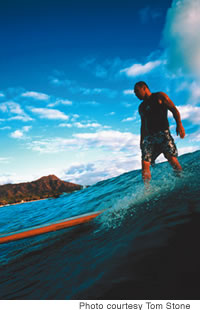Keeping A Surfing Tradition Alive

Wednesday - November 25, 2009
| Share
 Del.icio.us
Del.icio.us
|
Hawaii is home to countless ocean adventures, and through the years I’ve been fortunate - and game - to try just about everything.
There were exhilarating night dives off the Kona Coast with Keller Laros as we mingled with the massive manta rays. There was a heart-stopping encounter with dozens of sharks with the late Jimmy Hall and a heart-stomping swim with spinner dolphins off Nanakuli with Victor Lozano. There were emotional crossings of the Molokai Channel with canoe mates and an unforgettable whale-watching expedition with world-famous Jean-Michel Cousteau off Lahaina, where a magnificent humpback and her calf breached a few feet from our cameras.
I recently added another adventure to my treasure chest of magical moments thanks to legendary waterman Tom “Pohaku” Stone. But this one was very different from the rest. There was no fear, no crazy adrenaline rush and no intimidating animals involved. It was simple: just the ocean and two pieces of beautifully sculpted wood, one made of koa, the other from a wiliwili tree.
The rectangular-shaped koa and wiliwili resemble oversized ironing boards used to press slacks and dress shirts. But they are so much more. These precious woods represent history, a taste of old Hawaii and a gift to the world of surfing.
The “alaia” is a finless wooden board that was used by Hawaiians hundreds of years ago. In fact, when Capt. James Cook arrived in 1776, Hawaiians paddled to his ship on alaia boards.
“An alaia was a type of board that almost everyone used in Hawaii - all the commoners,” says Stone. “All the early images caught are individuals holding alaia boards.”
Finless wooden boards have resurfaced at beaches around the world and many mistakenly call them alaia. While Stone appreciates the world’s fascination with old Hawaii, he says some people are “selling the word” without a true understanding of its meaning.
“I think everybody is losing track of the importance of the history of alaia boards and the specialization that went into surfing,” says Stone. “For me personally, it’s a bastardization of my culture because not everything is an alaia.”
It’s one reason he teaches history before teaching anyone to ride. Surfing an alaia takes amazing skill and strength. Koa boards can weigh up to 100 pounds, and after a two-hour surf session, can weigh more than 130 pounds after water soaks into the wood. A wiliwili alaia is much lighter, some weighing less than 25 pounds.
Stone takes me to an isolated break outside Kakaako Park. The boards have no fins, so turning them requires moving your weight from side-to-side. There also is no leash, so watching old Hawaii come to life right before my eyes.
“It’s kind of spiritual. You know, you get that feeling of just being with the ocean and the board, and it’s an amazing feeling,” says Jardine. “You really appreciate what we have today and what our ancestors left behind.”
“When you get on something like this, you appreciate what our kupuna gave to the entire world,” says Stone.
It was at that moment I realized the importance of Stone’s message: Tradition and history should never be compromised.
A lesson learned without even taking a ride.
E-mail this story | Print this page | Comments (0) | Archive | RSS Comments (0) |
Most Recent Comment(s):













